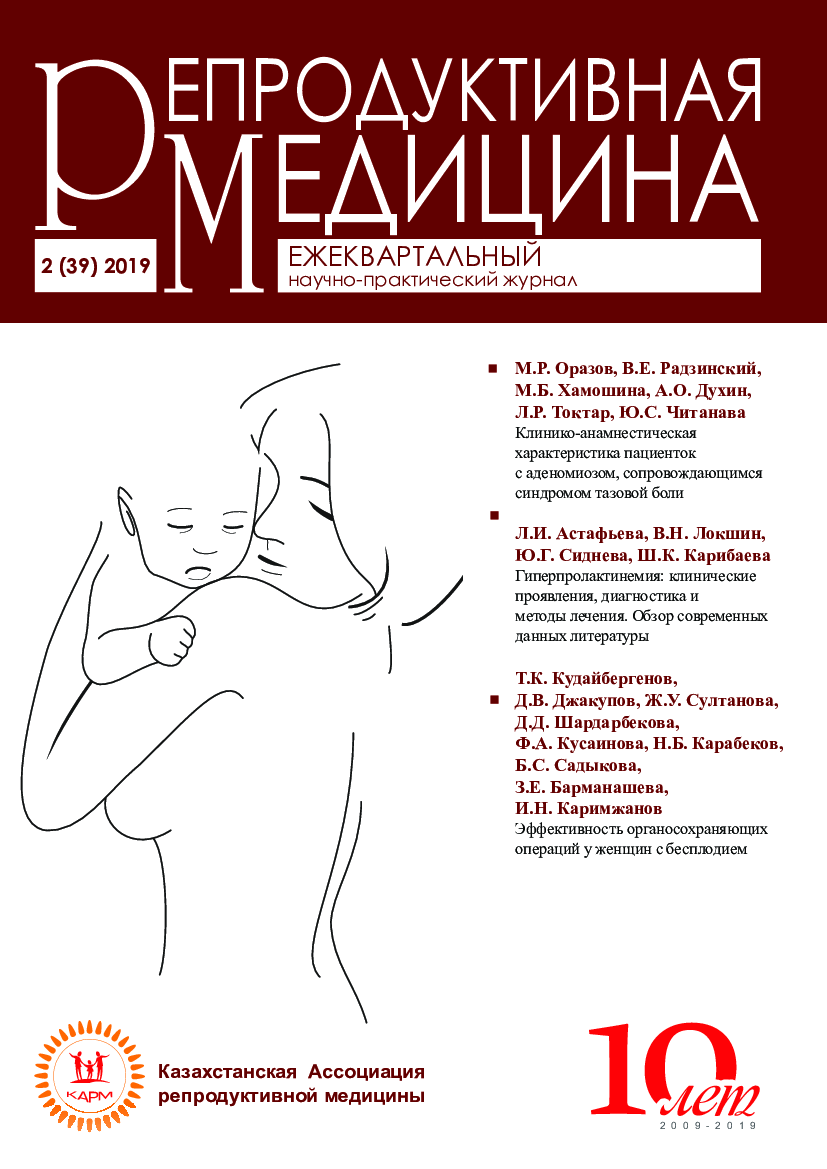Poor responders – outcome opportunities (clinical data)
Keywords:
infertility, poor response, low ovarian reserve, IVF, pregnancy rate, child-bearing rateAbstract
Ovarian reserve plays an important role in the adequate response of the ovary to ovarian stimulation and the production
of health ovule in vitro fertilization programs. Recently, new risk factors for a poor ovarian response to stimulation have been
established. The choice of stimulation scheme for a poor reserve is very important since the outcome of the entire program of
auxiliary reproductive technologies depends thereon.
References
Lokshin V., Valiev R., A. Rybina, Zaichenko K. “Poor responders” – modern ideas, principles of management in art programs. review. Bulletin of National Academy of Sciences of the republic of Kazakhstan ISSN 1991-3494 Volume 2, Number 378 (2019), 177 – 188 https://doi.org/10.32014/2019.2518-1467.54
Orazov M.R., Radzinsky V.Y., Khamoshina M.B., Lokshin V.N., Demyashkin G.A., Toktar L.R., Tokayeva E.C., Chitanava Yu. S.. Gonadotropin-releasing hormone agonists and antagonists: influence on neuroangiogenesis and apoptosis in eutopic endometrium in a therapy for recurrering endometriosis genitalis externa-associated pelvic pain in patients. Bulletin of National Academy of Sciences of Republic of Kazakhstan. 2018. Vol. 6, Number 376, 19-33. ISSN 1991-3494. https://doi.org/10.32014/2018.2518-1467
Ben-Rafael Z., D. Bider, U. Dan, M. Zolti, D. Levran, and S. Mashiach, “Combined gonadotropin releasing hormone agonist/ human menopausal gonadotropin therapy (GnRH-a/hMG) in normal, high, and poor responders to hMG,” Journal of In Vitro Fertilization and Embryo Transfer, vol. 8, no. 1, pp. 33–36, 1991. View at Publisher · View at Google Scholar · View at Scopus.
Rienzi L., A. Cobo, A. Paffoni et al., “Consistent and predictable delivery rates after oocyte vitrification: an observational longitudinal cohort multicentric study,” Human Reproduction, vol. 27, no. 6, pp. 1606–1612, 2012. View at Publisher · View at Google Scholar · View at Scopus.
Vos M. de, P. Devroey, and B. C. J. M. Fauser, “Primary ovarian insufficiency,” The Lancet, vol. 376, no. 9744, pp. 911–921, 2010. View at Publisher · View at Google Scholar · View at Scopus .
N. Soto, G. Iñiguez, P. López et al., “Anti-Müllerian hormone and inhibin B levels as markers of premature ovarian aging and transition to menopause in type 1 diabetes mellitus,” Human Reproduction, vol. 24, no. 11, pp. 2838–2844, 2009. View at Publisher · View at Google Scholar · View at Scopus.
H.H. Chang, M.J. Chen, M.-Y. Lu et al. “Iron overload is associated with low anti-müllerian hormone in women with transfusion-dependent β-thalassaemia,” British Journal of Obstetrics and Gynaecology, vol. 118, no. 7, pp. 825–831, 2011. View at Publisher · View at Google Scholar · View at Scopus.
G. Tropeano, C. Di Stasi, S. Amoroso, M. R. Gualano, L. Bonomo, and G. Scambia, “Long-term effects of uterine fibroid embolization on ovarian reserve: a prospective cohort study,” Fertility and Sterility, vol. 94, no. 6, pp. 2296–2300, 2010. View at Publisher · View at Google Scholar · View at Scopus.
Reproductive Endocrinology and Infertility Committee, Family Physicians Advisory Committee, Maternal-Fetal Medicine Committee, Executive and Council of the Society of Obstetricians, K. Liu, and A. Case, “Advanced reproductive age and fertility,” Journal of Obstetrics and Gynaecology Canada: JOGC, vol. 33, no. 11, pp. 1165–1175, 2011. View at Google Scholar · View at Scopus.
U. Ulug, I. Ben-Shlomo, E. Turan, H. F. Erden, M. Ali Akman, and M. Bahceci, “Conception rates following assisted
reproduction in poor responder patients: a retrospective study in 300 consecutive cycles,” Reproductive BioMedicine Online, vol. 6, no. 4, pp. 439–443, 2003. View at Google Scholar · View at Scopus.
Zhen X. M., J. Qiao, R. Li, L. N. Wang, and P. Liu, “The clinical analysis of poor ovarian response in in-vitro-fertilization embryo-transfer among Chinese couples,” Journal of Assisted Reproduction and Genetics, vol. 25, no. 1, pp. 17–22, 2008. View at Publisher · View at Google Scholar · View at Scopus.
El-Toukh reduced ovarian reserve—an eight year study,” Human Reproduction, vol. 17, no. 6, pp. 1519–1524, 2002. View at Publishery T., Y. Khalaf, R. Hart, A. Taylor, and P. Braude, “Young age does not protect against the adverse effects of View at Google Scholar View at Scopus.
Polyzos N. P., M. Nwoye, R. Corona et al., “Live birth rates in Bologna poor responders treated with ovarian stimulation for IVF/ICSI,” Reproductive BioMedicine Online, vol. 28, no. 4, pp. 469–474, 2014.View at Publisher · View at Google Scholar.
Poor responders: still a problem. (Frydman R. Fertil Steril. 2011).
Gardner DK1, Lane M. Culture and selection of viable blastocysts: a feasible proposition for human IVF? Hum Reprod Update. 1997 Jul-Aug;3(4):367-82.
Valiev R.K ., Lokshin V., Karibaeva Sh.K., A.Malik, A.N.Rybina, K.T.Nigmetova, K.A.Urazimbetova Possibilities of pgs
in overcoming the influence of age on art results. Reproductive Medicine 2017 #4(33).
Additional Files
Published
How to Cite
Issue
Section
License
The articles published in this Journal are licensed under the CC BY-NC-ND 4.0 (Creative Commons Attribution – Non-Commercial – No Derivatives 4.0 International) license, which provides for their non-commercial use only. Under this license, users have the right to copy and distribute the material in copyright but are not permitted to modify or use it for commercial purposes. Full details on the licensing are available at https://creativecommons.org/licenses/by-nc-nd/4.0/.




